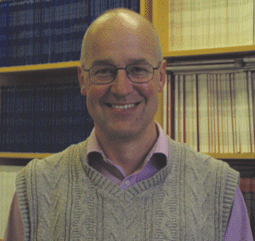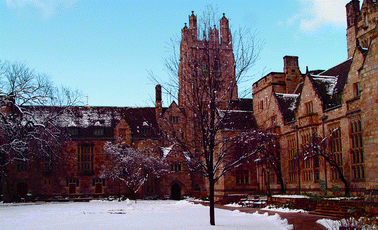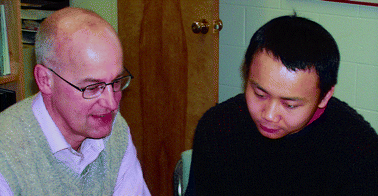Profile
Andrew D. Hamilton
Professor of Chemistry, Yale University, USA
Abstract
Organic & Biomolecular Chemistry profiles Professor Andrew D. Hamilton
| 1974: B.Sc. Chemistry, Exeter University 1976: M.Sc., University of British Columbia 1980: PhD, University of Cambridge 1980–81: Postdoctoral fellow, University of Strasbourg 1981–88: Assistant Professor, Princeton University 1988–92: Associate Professor, University of Pittsburgh 1992–97: Full Professor, University of Pittsburgh 1994–97: Chair of the Department of Chemistry, University of Pittsburgh 1997–present: Irénée duPont Professor of Chemistry, Yale University 1998–present: Professor, Department of Molecular Biophysics and Biochemistry, Yale University 1999–present: Chair of the Department of Chemistry, Yale University |
Andrew Hamilton was born in 1952 in the Surrey county town of Guildford, almost exactly halfway between London and the naval port of Portsmouth. Since the horse-drawn trip between these two great cities took two days, much of his young adult years were spent visiting pubs that proclaimed “Nelson slept here!” In one of those coincidences that keep life interesting, he now lives with his wife, Jennie, and their three children in the small New England town of Guilford, Connecticut, which despite losing a ‘d’ to its old-world progenitor, has the added delight of a location on Long Island Sound.
In his copious free time he tries to participate as much as possible in the trials and tribulations of family life. These have included coaching for a number of years the soccer teams of his growing daughter. In fact, these activities have had professional consequences since his most productive scientific collaboration (with cancer biologist Saïd Sebti) began when they both were coaches on the same team. His own sporting fantasies have not entirely been sacrificed to advancing years. Most Sunday mornings, with 21 other like-minded souls, he chases his lost youth in an over-40 soccer league (for which he more than qualifies). In fact, he holds as his greatest accomplishment last year being top goal scorer for his team (the Guilford Black Eagles) and thus the self-proclaimed Michael Owen of Southern Connecticut.
When did you first realize that you wanted to work in chemistry?
I was very much a late developer and had no interest in chemistry sets as a child. In high school and the first half of my college career I spent a little too much time playing rugby and cricket, and engaging in the evening activities that invariably accompanied them. In the summer before my final year I started to focus more on chemistry and I began to realize the beauty of organic transformations and the challenge of translating mechanistic understanding into synthetic innovation.Who was the first person to inspire you to research in chemistry?
I had the good fortune to be influenced by three outstanding, and patient, mentors early in my research career. After leaving Exeter I spent two years studying for an M.Sc. at the University of British Columbia in Vancouver. In addition to learning to ski, I worked on various aspects of porphyrin chemistry with Professor David Dolphin. From him I saw that organic chemistry could be both fun and immensely rewarding. I returned to Cambridge for my PhD in the group of Professor Sir Alan Battersby who introduced me to the rigors of the subject and its role in answering questions in biology. More than this, I saw from him that a scientific career could be conducted and students motivated with a positive and enthusiastic outlook. My post-doc with Professor Jean-Marie Lehn in Strasbourg exposed me to the great breadth of the subject and the power of a creative mind in forging new areas of investigation. All three of these marvelous mentors inspired me to a career in chemistry and set standards of innovation and accomplishment to which I aspire, but invariably fall short.Tell us something about the areas of chemistry you are currently researching
The principal challenge that we tackle in my lab can be summed up by the refrain “if nature can do it why can't we?” The main challenge is, therefore, to reproduce in a synthetic structure, the intrinsic chemical microenvironment of a biological system that can lead to recognition and catalysis. A particularly intriguing goal is to reproduce in a non-peptidic molecule the recognition of features of a peptide or even a region of a protein surface. In recent years we have designed a wide variety of peptidomimetics that reproduce the conformational and peptide recognition properties of a short peptide. These molecules have been targeted to proteins involved in disease and some have proved particularly effective in slowing the growth of human tumors in animal models and others in blocking parasitic diseases such as malaria, African sleeping sickness and Chargas disease. A major current goal is to extend this idea to entire protein surfaces with the synthesis of proteomimetics that can disrupt important protein–protein interactions. We have prepared mimics of extended α-helices and also of non-contiguous domains and shown that they can bind to the exterior surface of other proteins and modulate their function. A further area of interest is the application of controlled intermolecular interactions in materials research and the design of functional gelators. We are particularly interested in the development of synthetic molecules that selectively recognize the surface of a growing crystal and so influence its size and morphology. Once again nature provides an inspiration in the complex microskeletons of certain organisms and even the beautiful shapes of sea shells.Why did you decide to research in these areas of chemistry?
All three of my mentors impressed on me the power of organic chemistry to probe, mimic and modulate biology. Nowhere was this more true than in the area of molecular recognition. The brilliant work of Pederson, Cram and Lehn (and indeed many others) had shown that synthetic molecules (crown ethers, spherands, and cryptands) could have exquisite selectivity in complexing alkali and alkaline earth metals. But when I began my independent career there were relatively few examples of synthetic hosts that could bind to small organic molecules such as peptides or drugs with high affinity and selectivity. A beautiful natural example was the antibiotic vancomycin to whose structure I was introduced by the group of Professor Dudley Williams during my time at Cambridge. We made the first synthetic analogs of vancomycin but were always limited in their application by some difficult medium ring forming synthetic steps (vancomycin itself has only recently been synthesized). It was the search for simple, synthetic mimics of the hydrogen bonding recognition site of vancomycin that led us to aminopyridines and related subunits as ready recognition components in synthetic hosts. Many of these systems worked best in organic solvents and recently we have challenged ourselves to achieve similar recognition in water. In order to overcome the natural “aquaphobia” of most organic chemists, we launched into water with the design of agents that recognized small peptides, larger α-helices and even entire protein surfaces. Our hope is that these studies will eventually allow us to extend our molecular recognition strategies to clinically important proteins inside living cells.Where would you like to see your research in both the short and long term?
The short term and the long term are intimately connected as one cannot get to the latter without going through the former! We have always taken our molecular recognition studies forward incrementally, starting with small molecules and carboxylates, progressing to peptides and α-helices and recently targeting large surface areas of a protein surface. My long term hope is that this work will help us better understand the nature of small molecule and protein–protein interactions, and allow us to efficiently design synthetic disruptors of cellular signaling pathways. We have already reported a molecule that binds to platelet derived growth factor and blocks its binding to a cell-surface receptor in both cell culture and a mouse model of human cancer.What would you most like to achieve in your lifetime in chemistry?
All of us like to think that it is our research that is our most important achievement and contribution to society. But I firmly believe that the most important thing we produce are the people (the undergraduates, graduate students and post-docs) who pass through our laboratories and classrooms. So by the end of my career I would most like to have achieved the education and training of a group of independent, free-thinking, imaginative and effective scientists.What do you find most enjoyable about your job on a daily basis?
The joy of a career in research is that every day is different. Many are miserable (when a reaction fails, a paper is rejected or a grant is declined) but some are sublime (when a long-anticipated problem is solved and research truly moves forward). This constant variety of experience leads to highs and lows, but never boredom. For this, a life in research is indeed a privilege. An equal privilege is the opportunity to interact daily with graduate students and post-docs in my research group who never cease to amaze me with new ideas and ways of tackling problems with which I have struggled. I also get immense pleasure from teaching. The challenge of transmitting the excitement and beauty of our subject to a student audience, some of whom would rather be elsewhere, is one that I enjoy.What frequently annoys you about your job?
Call me Pollyanna, but very little annoys me in this job—apart, of course, from grant reviewers who sometimes fail to see the unalloyed brilliance of my research ideas (I am sure this has nothing to do with my occasionally garbled prose)—and, of course, deadlines that are the bane of our lives but without which very little would get done.Which scientist do you admire through history and why?
Max Perutz for revealing proteins for what they really are, large organic molecules whose properties can be understood in terms of the principles of organic chemistry and whose function can be mimicked and modulated by clever synthetic design.If you could successfully solve any scientific problem, what would it be and why?
Oh, there are so many! In short- to mid-term there is much still to be achieved in understanding protein–protein interactions and identifying synthetic agents that can effectively and selectively disrupt them. In the long term I would like to see these approaches applied to a successful development of anti-cancer therapies that show good in vivo properties and selectivities for tumors over normal tissue. In the even longer term the de novo design and synthesis of a true artificial enzyme capable of catalyzing a difficult reaction, such as amide bond hydrolysis, would be an important goal.Footnote |
| † Photographs show Professor Hamilton, Branford College at Yale and Professor Hamilton in discussions with graduate student, Hubert Yin. |
| This journal is © The Royal Society of Chemistry 2003 |



